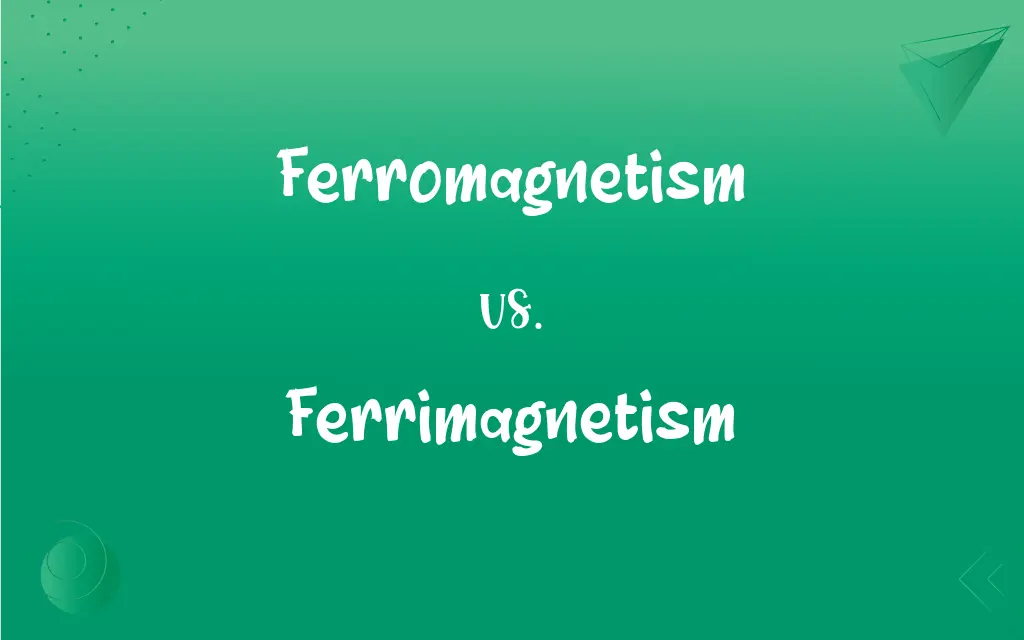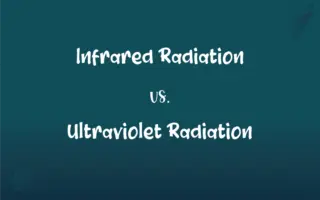Ferromagnetism vs. Ferrimagnetism: What's the Difference?
Edited by Aimie Carlson || By Janet White || Published on June 27, 2024
Ferromagnetism involves materials that can be permanently magnetized, while ferrimagnetism refers to materials with magnetic domains that are unequally aligned yet result in net magnetization.

Key Differences
Ferromagnetism and ferrimagnetism are both types of magnetic ordering found in solids, but they differ in the alignment and magnitude of their magnetic moments. Ferromagnetism is characterized by the parallel alignment of magnetic moments, leading to strong internal magnetization. Ferrimagnetism, on the other hand, occurs in materials where magnetic moments are aligned in opposite directions, but not all moments cancel each other out due to differences in their magnitudes.
The main distinction between ferromagnetism and ferrimagnetism lies in their microscopic magnetic moment alignment. In ferromagnetism, all magnetic moments align in the same direction when magnetized, leading to strong magnetic fields. Ferrimagnetism involves a more complex interaction, where despite opposing alignments, a net magnetic moment is produced due to unequal magnitudes of the individual moments. This difference in alignment affects the magnetic properties and applications of the materials.
From an application perspective, ferromagnetic materials are widely used in making permanent magnets, magnetic storage media, and various electronic devices due to their ability to maintain a persistent magnetic state. Ferrimagnetic materials, while also magnetic, are often utilized in different types of magnetic recording media, microwave devices, and as catalysts in chemical reactions, reflecting their unique magnetic characteristics.
Both ferromagnetism and ferrimagnetism play crucial roles in modern technology and scientific research. Understanding the differences between these types of magnetism not only aids in selecting appropriate materials for specific applications but also in the development of new technologies that leverage the unique properties of magnetic materials.
Comparison Chart
Magnetic Moment Alignment
Parallel alignment of all magnetic moments.
Antiparallel alignment with unequal magnitudes, resulting in net magnetization.
ADVERTISEMENT
Examples of Materials
Iron, Cobalt, Nickel
Magnetite, Ferrites
Strength of Magnetization
Strong magnetization, materials can become permanent magnets.
Weaker net magnetization than ferromagnetic materials.
Temperature Dependence
Above the Curie temperature, they become paramagnetic.
Above the Curie temperature, they also become paramagnetic.
Application
Used in permanent magnets, storage devices, and electronic components.
Used in magnetic recording media, microwave devices, and catalysts.
Ferromagnetism and Ferrimagnetism Definitions
Ferromagnetism
Dependent on the temperature, losing magnetism above the Curie point.
Ferromagnetism in certain alloys disappears when heated above their Curie temperature.
ADVERTISEMENT
Ferrimagnetism
Results in a net magnetization due to unequal antiparallel spins.
Ferrimagnetism is key to the operation of certain types of microwave devices.
Ferromagnetism
A phenomenon where materials exhibit strong, permanent magnetization.
The ferromagnetism of iron allows it to be used in making permanent magnets.
Ferrimagnetism
A form of magnetism with opposing but unequal magnetic moments.
Ferrimagnetism in magnetite makes it an excellent magnetic material.
Ferromagnetism
Magnetic ordering with parallel alignment of spins.
Ferromagnetism in cobalt contributes to its high magnetic coercivity.
Ferrimagnetism
Exhibited by materials like ferrites and some oxides.
The ferrimagnetism of ferrites allows them to be used in magnetic core materials.
Ferromagnetism
Materials exhibiting ferromagnetism can retain magnetization without an external field.
Nickel shows ferromagnetism, making it valuable in magnetic alloys.
Ferrimagnetism
Useful in applications requiring moderate magnetization.
The ferrimagnetism of magnetite nanoparticles is exploited in magnetic resonance imaging (MRI).
Ferromagnetism
Characterized by a high magnetic permeability and susceptibility.
Ferromagnetism enables the construction of efficient electromagnetic devices.
Ferrimagnetism
Magnetic properties decrease above the Curie temperature.
Ferrimagnetism in garnets is used for their magnetic and optical properties.
Ferromagnetism
Of or characteristic of substances such as iron, nickel, or cobalt and various alloys that exhibit extremely high magnetic permeability, a characteristic saturation point, and magnetic hysteresis.
Ferrimagnetism
(physics) a form of antiferromagnetism in which some magnetization remains below a critical temperature (the Neel temperature)
Ferromagnetism
(physics) The phenomenon whereby certain substances can become permanent magnets when subjected to a magnetic field.
Ferrimagnetism
A phenomenon in ferrites where there can be incomplete cancellation of antiferromagnetic arranged spins giving a net magnetic moment
Ferromagnetism
Phenomenon exhibited by materials like iron (nickel or cobalt) that become magnetized in a magnetic field and retain their magnetism when the field is removed
FAQs
What defines ferrimagnetism?
Ferrimagnetism is characterized by opposing, unequal magnetic moments that result in a net magnetization.
What are the applications of ferrimagnetic materials?
Ferrimagnetic materials are used in magnetic recording media, microwave devices, and as catalysts.
What is the Curie temperature?
The Curie temperature is the critical point at which a magnetic material loses its permanent magnetism.
What makes ferrimagnetic materials different from ferromagnetic materials?
The key difference is in the alignment and magnitude of their magnetic moments.
Can ferromagnetic materials lose their magnetism?
Yes, above the Curie temperature, ferromagnetic materials become paramagnetic and lose their permanent magnetism.
What happens to ferrimagnetic materials above their Curie temperature?
They lose their ferrimagnetism and become paramagnetic.
What defines ferromagnetism?
Ferromagnetism is defined by the parallel alignment of spins resulting in strong, permanent magnetization.
Are all magnetic materials ferromagnetic?
No, only certain materials like iron, nickel, and cobalt exhibit ferromagnetism.
What role does temperature play in magnetism?
Temperature can cause a material to transition between magnetic states, affecting its magnetism.
Can ferrimagnetism be found in nature?
Yes, ferrimagnetism is naturally present in minerals like magnetite.
Do ferrimagnetic materials have coercivity?
Yes, but it varies depending on the material's composition and structure.
How are ferromagnetic materials used in electronics?
They are used in making magnetic storage media, permanent magnets, and in electromagnetic components.
Can ferrimagnetic materials be magnetized?
Yes, but their net magnetization is typically weaker than that of ferromagnetic materials.
How do ferromagnetic materials become magnetized?
By exposure to an external magnetic field, which aligns their magnetic domains.
What research is being done on ferromagnetism and ferrimagnetism?
Research focuses on understanding magnetic phenomena at the atomic level and developing new magnetic materials with enhanced properties.
Why are ferromagnetic materials important in storage devices?
Their ability to retain magnetization makes them ideal for storing data in magnetic form.
Are there synthetic ferromagnetic materials?
Yes, several synthetic ferromagnetic materials are engineered for specific applications.
What is magnetic coercivity?
Magnetic coercivity is the resistance of a ferromagnetic material to becoming demagnetized.
Can the magnetism of ferromagnetic materials be enhanced?
Yes, by alloying and processing techniques that optimize their magnetic domains.
How are ferrimagnetic materials synthesized?
Through various chemical processes that control the composition and structure of the material.
About Author
Written by
Janet WhiteJanet White has been an esteemed writer and blogger for Difference Wiki. Holding a Master's degree in Science and Medical Journalism from the prestigious Boston University, she has consistently demonstrated her expertise and passion for her field. When she's not immersed in her work, Janet relishes her time exercising, delving into a good book, and cherishing moments with friends and family.
Edited by
Aimie CarlsonAimie Carlson, holding a master's degree in English literature, is a fervent English language enthusiast. She lends her writing talents to Difference Wiki, a prominent website that specializes in comparisons, offering readers insightful analyses that both captivate and inform.







































































